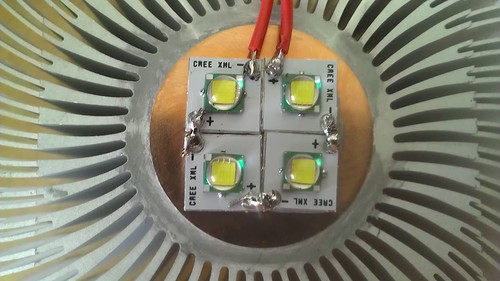@ AnAppleSnail:
I'm still reading around here and learning, so in the meantime here are a few intrigues and questions:
1. That looks awesome! So I take it you have two 5W LEDs of each colour there? Do the colours render well in post? Any examples if it's not too much to ask? Have you tried only using a single colour, and do the limited wavelengths make that much of a difference?
2. Also, running them at 80W total, you state a guestimate reduced 25% duty cycle, but is that a realistic estimate? I've read around here that LEDs are ok with being over run for short periods, but what's your experience with longer running times at 40w? You said they stay cool, but have any run far shorter than lets say a 50% duty cycle? That's partly the reason for the 100 watter. That way I don't run it at it's full power, preserve the leds, and still get a decent duty cycle (that's the hope anyway). And, well, if I need the full power, it's there too

3. "With burst operation you have to separate the heat sink from the heat rejecters. The copper slug is a heat sink - it holds heat by cooling the LEDs after, say, a 40W burst (Or 80W for about 180% power). The aluminum vanes then release the heat, which requires a fan when above about 10W average power. Running continuously at 20W it stays cool to the touch."
When it comes to sinks, I wanted to know what was best for my LED in the long run, and I was amazed last night (and you might be interested to hear this too) to learn the following:
I tried a 1750 ohm resistor at 240v to get roughly a 35w output. The resistor had a special case such that it could be connected to a flat plate of a sink and cool nicely, thus testing the heat sink. I then tested two sinks in air without fans. After roughly 15min, a sink very similar to the one you've show got to 87C, where as a sink of the same size, just made with a thicker base, and far thicker and sparsely separated fins (like what you see on good old amplifiers), only got to 48C. I didn't measure the resistor on the first sink, but on the second, the resistor only got to 57C. All this with a room temp of 17C, and no fans to cool anything. Both stayed stable at those given temperatures after that +- a few degrees. I was blown away at how poor a sink the intel cooler really was; that or I'm really missing something here. Based on what you said in the quotation above, what's your opinion on these results?
@aarke98:
Thank you very much, I actually tracked those down through the forum yesterday too. The look way cool, and I was tempted; especially as they can supply so much, and have such small circuitry (or so it seemed). Funnily enough, and here is the kicker, I looked them up on the only Australian reseller, and they only rated them to 1300mA, which is why I didn't give them a second thought. You might be interested in seeing that for yourself:
http://www.cutter.com.au/search.php?pg=1&stext=hyperboost&sprice=&stype=&scat=&sman=
Instead, I opted for buying and editing a simple circuit, like the one in the last link in my previous post. I hope it does the job, we shall see I suppose.
Thanks for all the help and ideas everyone,
Julius



